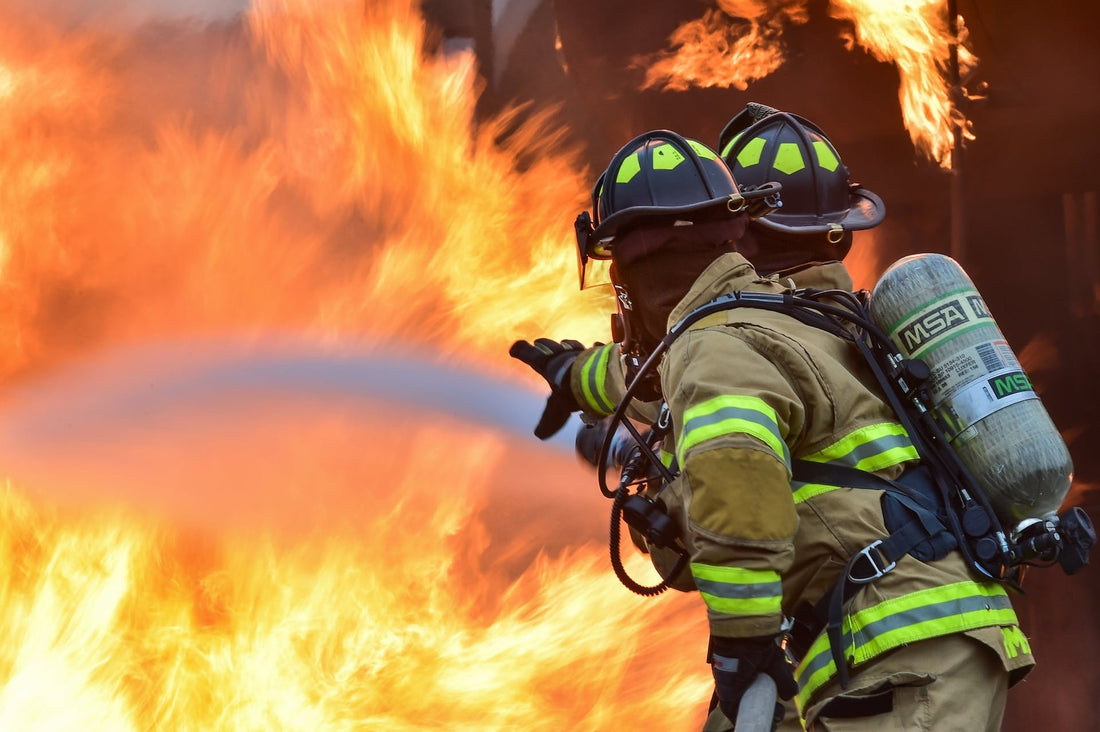Introduction
Firefighters often confront extreme conditions in their line of duty, requiring protective gear that ensures both safety and comfort. Among the array of materials used in firefighting apparel, merino wool stands out as a reliable safeguard due to its exceptional fire-resistant properties. This blog seeks to delve into the critical role merino wool plays in firefighters’ protective clothing. With a focus on its high melting point and ability to withstand intense heat, this discussion aims to underscore why merino wool emerges as the optimal choice for ensuring the safety and well-being of those on the front lines of fire emergencies. Moreover, this blog explores a lesser-known but crucial application of merino wool, drawing insights from motorsports, where racecar drivers have relied on wool for facial fire protection, exemplified by legends like Nikki Lauda. Through these insights and examples, we uncover the intrinsic characteristics that position merino wool as an indispensable ally in the fight against fire-related hazards, illustrating how this natural fiber goes beyond traditional uses to serve as a protective shield for those who dedicate their lives to saving others.
Understanding Wool’s High Melting Point
Understanding the significance of a high melting point in materials is crucial in appreciating the protective value it offers, especially for firefighters facing extreme heat and potential exposure to flames. The melting point refers to the temperature at which a substance transitions from a solid to a liquid state.

In the context of firefighting, garments made from materials with high melting points are paramount. When exposed to intense heat, materials with low melting points, such as synthetics, can rapidly melt or even combust, posing serious risks to the wearer. This scenario could result in burns, skin injuries, and further complications, endangering the safety of firefighters in the line of duty.
Merino wool stands out due to its high melting point compared to other materials commonly used in firefighting gear. This innate property allows merino wool to resist ignition and withstand higher temperatures before it begins to melt. As a result, when exposed to flames, merino wool fibers char and form a protective barrier, reducing the risk of the material sticking to the skin or causing burns. This fire-resistant nature is crucial for providing critical seconds of protection in the event of exposure to flames, allowing firefighters to perform their duties with an added layer of safety and confidence.
The high melting point of merino wool significantly contributes to its suitability for firefighting gear. Its ability to withstand extreme heat without melting or contributing to burn injuries makes it an excellent choice for protective clothing, ensuring the safety and well-being of those who rely on it in hazardous environments.
The Racing World’s Embrace of Wool for Fire Protection
Beyond firefighting, the racing industry has long recognized the inherent fire-resistant properties of merino wool. Racing drivers, particularly in Formula 1 and other high-speed competitions, prioritize safety gear that shields them from potential fire hazards in the event of a crash or vehicle malfunction.

One notable example is the late Formula 1 racing legend, Niki Lauda, who wore a white wool face garment during races. This seemingly simple choice held immense significance, as wool’s fire-resistant properties offered Lauda a layer of protection in the unfortunate event of a fire-related accident. The use of wool around the face provided an additional safeguard against flames, preventing potential burns or injuries.
Wool’s ability to resist combustion at high temperatures makes it an ideal material for racing attire. Drivers often utilize woolen undergarments, head socks, or balaclavas made from merino wool to shield themselves from fire and minimize the risk of burns in case of fire-related incidents on the track.
The natural fire-resistant qualities of merino wool, coupled with its moisture-wicking capabilities and comfort, make it a preferred choice among racing professionals. Its reliability as a protective garment further underscores its significance in environments where safety is paramount, solidifying its position as a crucial element in racing safety apparel.
Merino Wool’s Role in Firefighting Gear
Firefighters face life-threatening situations daily, confronting intense heat and flames while protecting lives and property. In such scenarios, having the right protective gear is critical. Merino wool has emerged as a game-changer in the firefighting industry due to its exceptional fire-resistant properties and practical benefits.
One of the key reasons merino wool stands out in firefighting gear is its high melting point, making it inherently fire-resistant. Unlike synthetic materials that melt or burn when exposed to heat, merino wool has a higher ignition point, ensuring it doesn’t ignite or stick to the skin when subjected to flames. This critical attribute significantly reduces the risk of burns and provides added safety for firefighters operating in hazardous environments.
Moreover, merino wool’s natural moisture-wicking ability keeps firefighters dry by absorbing sweat and moisture away from the skin. This feature is invaluable during prolonged operations, preventing discomfort, chafing, and potential skin issues caused by damp clothing, ensuring firefighters remain focused and comfortable throughout their duties.
In addition to its fire-resistant and moisture-wicking properties, merino wool is known for being lightweight, breathable, and odor-resistant. These characteristics enhance its suitability for firefighting apparel, allowing firefighters to move freely and stay fresh, even during extended missions in intense heat.
The use of merino wool in firefighting gear exemplifies its versatility and effectiveness in high-risk environments, earning it a well-deserved reputation as a reliable and protective material for those working in the line of fire.
Conclusion
In conclusion, the importance of merino wool in the realm of firefighting cannot be overstated. Its remarkable qualities as a fire-resistant material significantly elevate the safety standards and comfort levels for firefighters amid the most challenging and hazardous conditions.

The high melting point of merino wool plays a pivotal role in its effectiveness as a protective garment for firefighters. This property enables it to endure intense heat without melting or contributing to burn injuries. Unlike synthetic materials, which pose risks of melting and sticking to the skin, merino wool acts as a robust barrier, reducing the severity of potential burns and injuries.
Moreover, beyond its fire-resistant nature, merino wool offers superior comfort and functionality. Its natural breathability, moisture-wicking properties, and ability to regulate temperature contribute to the overall comfort of firefighters during arduous tasks, ensuring they can focus on their duties without compromising on safety.
The historical use of wool by race car drivers, like the iconic Nikki Lauda, further underscores its reliability and effectiveness in shielding against fire hazards. As these drivers relied on wool for protection during high-speed races, its credibility in offering fire protection stands validated.
Overall, merino wool emerges as an indispensable asset in the firefighting domain, combining exceptional fire resistance, comfort, and proven reliability. Its role in safeguarding firefighters and providing them with peace of mind in high-risk situations solidifies its position as a material of choice in protective gear, elevating safety standards and ensuring the well-being of those who bravely protect our communities.

